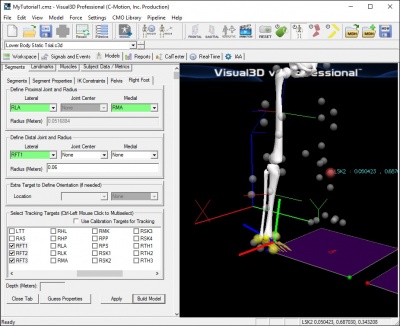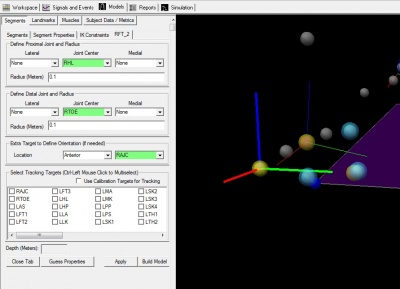Joint Angle
| Language: | English • français • italiano • português • español |
|---|
Joint angles represent a conceptual challenge to many users. Part of the challenge is related to the fact that joint angles are not vectors (unlike every other Kinematic variable in Visual3D). This means that they can't be added or subtracted, which makes the specification of a reference angle awkward. Another part of the challenge is related to the fact that there are a number of clinical/sports related conventions that specify a reference angle that is often not consistent with the definition of the segment coordinate systems in Visual3D, which usually requires Visual3D users to create Virtual Segments whose segment coordinate systems are consistent.
A more insidious problem is that there are joints, such as the shoulder, for which there is no single definition of the joint angle that is anatomically meaningful for the full range of motion of the joint. The consequence is that there is no standard sequence of rotations for describing the shoulder motion, despite the recommendation by the International Shoulder Group.
Further information about joint angles can be found in the Research Methods in Biomechanics textbook and in Tom Kepple's lecture from the University of Delaware.
Transformation Matrix
A Joint Angle is the transformation between two coordinate system that is described by a rotation matrix.
This rotation matrix is rarely used to report the joint angle. From the rotation matrix several different representations are possible, such as Cardan/Euler angle, Helical angle, Quaternion. All representations of the transformation are equivalent but the interpretation of the joint angle relative to the anatomy varies with the description.
Units for Joint Angles
Joint Angles, Joint Angular Velocity, and Joint Angular Acceleration are the only signals in Visual3D that don't use standard MKS units. Visual3D uses degrees, degrees/sec, and degrees/sec^2. These are traditional units in Gait Analysis and we have followed the trend.
Visual3D Default Joint Angle Conventions
To illustrate the default segment coordinate system in Visual3D, let's look at the right and left legs. The default segment coordinate system in Visual3D is defined as follows:
The default Cardan sequence for the calculation of joint angles is x-y-z, which is equivalent to:
- flexion/extension-abduction/adduction-axial rotation
Right Leg
- x-lateral
- y-anterior
- z-up
Left Leg
- x-medial
- y-anterior
- z-up
The default sign conventions for describing the joint angles are as follows:
Right Leg
- Knee(EXT+) (ADD+) (INTROT+)
- Hip(FL+)(ADD+) (INTROT+)
Left Leg
- Knee(EXT+) (ABD+) (EXTROT+)
- Hip(FL+)(ABD+) (EXTROT+)
The case of the Ankle Angle
The ankle is especially confusing because of differences between the typical kinetic foot and the typical kinematic only foot.
The typical kinetic foot is displayed here:
For this representation of the foot segment the z-axis is directed from the metatarsals to the ankle center.
The sign convention for the ankle angle defined using the kinetic foot relative to the shank segment is:
Right Leg
- Ankle (DFL+) (FFADDUCTION+) (EVER+)
Left Leg
- Ankle (DFL+) (FFABDUCTION+) (INVER+)
A common kinematic only foot is displayed here:
For this representation of the virtual foot segment the y-axis is directed from the heel to the toe.
The sign convention for the ankle angle defined using this kinematic foot relative to the shank segment is:
Right Leg
- Ankle (DFL+) (INVER+) (FFADDUCTION+)
Left Leg
- Ankle (DFL+) (EVER+) (FFABDUCTION+)
The Effect of the Right Hand Rule
As discussed in the Visual3D Default Joint Angle Conventions section above on this page, the medial and lateral coordinate system directions for left and right sides are different. This will effect the sign convention for joint angles. Meaning that the sign convention is not consistent between left and right sides. For example, inward rotation of the right leg (rotation about the long axis toward medial) is positive, but inward rotation of the left leg (rotation about the long axis toward medial) is negative.
However, all joint angles are treated the same in Visual3D, so the direction of positive angle is determined with respect to the segment coordinate system of the reference segment; using the Right Hand Rule.
The result of this decision is that flexion/extension has the same sign for left and right legs, but inward/outward rotation and abduction/adduction have opposite signs.
The user can change this by negating the necessary terms when the joint angle is defined in the Compute Model Based Items Dialog. Refer here for an example.
The Joint Coordinate System
As a default, Visual3D calculates Joint Angles using a Cardan sequence of rotations. In the section Visual3D Default Joint Angle Conventions on this page, we detailed the Visual3D default segment coordinate system (z-up, y-anterior). Therefore the cardan sequence X-Y-Z is equivalent to the Joint Coordinate System.
If the user has modified the Segment Coordinate System from the Visual3D default, then more care must be taken in determining the sequence of rotations that is equivalent to the Joint Coordinate System. The sequence should be selected as flexion/extension - abduction/adduction - axial rotation.
For a segment coordinate system defined as y-up and x-anterior, the Cardan Sequence equivalent to the Joint Coordinate system is Z-X-Y.
In other words, the first rotation is flexion/extension about the reference coordinate system, the last rotation is axial rotation about the other coordinate system, and the middle rotation is about an axis perpendicular to the other two axes.
Note: Visual3D will only allow a right hand coordinate system so the positive direction of rotation about an axis will need to be verified by inspecting the Segment Coordinate System visually in Visual3D's Model Builder mode.
Cole GK, Nigg BM, Ronsky JL, Yeadon MR (1993) Application of the Joint Coordinate System to Three-Dimensional Joint Attitude and Movement Representation: A Standardization Proposal. J Biomech Eng, 115, 344-9
Note: Grood/Suntay have a different sign convention, and they have an offset of pi/2 in the second rotation (ab-adduction). If you account for those differences, the XYZ Cardan sequence is equivalent to the Joint Coordinate System.
Cardan Sequence
In early versions of Visual3D (version 2 and lower), we output the 3 components of the Cardan angle in terms of the first, second and third rotation. This was confusing to people because the edit report dialog refers to the first three components as XYZ. In Version 3.00.3 we changed the output so that the X component of the joint angle refers to the rotation about the X axis regardless of the sequence, similarly for Y and Z rotations.
Euler Sequence
In version 3.28 we introduced the Euler sequences (e.g. ZYZ), in which the first and third component are the same. In this case instead of referring to the components as XYZ, we revert to our original scheme, in which the output angle is defined with respect to the first axis, second axis, and third axes.
Helical Angle
The helical angle calculation is output as vector rather than a unit vector and an angle of rotation.
Visual3d is simply multiplying the angle of the rotation by the three components of the unit vector.
Is possible to calculate a helical axis (vector and angle) in Visual 3D?
The answer yes by going the opposite way. To do this you would have to first compute the magnitude of the output of the “Compute Model BasedàHelical_Angle” and then divide each of the components of this vector by the magnitude.
To actually do this inside Visual3d you would:
Step 1) Use “Compute Model BasedàHelical_Angle” to get the helical angle as a vector.
Step 2) Use the Pipleline command “Signal Magnitude” (which is under Signal Math in the Pipeline) to get the magnitude of the “Compute Model BasedàHelical_Angle”. This would give you the angle you are looking for.
Step 3) Use the pipeline command Divide_Signal_BY_Constant to divide the result of “Compute Model BasedàHelical_Angle” by the result of the Signal Magnitude (Divide_Signal_BY_Constant is also under Signal Math in the Pipeline). This will give you the unit vector you are looking for.
Joint Angle Normalization
Normalization is the process of referencing a joint (or segment) angle to the reference posture. The reference posture is the static posture (often referred to as the standing pose) captured as the model posture (e.g. the C3D file used to define the link model). In Visual3D the reference posture is the static trial used for the link model. Joint angles aren't vectors, which means they can not be added or subtracted. A normalized joint angle is, therefore, not computed as 3 offsets from a reference posture.
We recommend the use of virtual segments, which can be defined so that they explicitly cause the static trial to be a reference posture. For example, see the following topics for normalizing the ankle joint angle.
Note: In Visual3D joint angles are simply the transformation from one segment coordinate system to another segment coordinate system, so it follows that the definition (e.g. orientation) of the segment coordinate systems matters. For example, if two segment coordinate systems are aligned perfectly (even though they may be displaced from each other) the resulting joint angle signal is zero.
| Deprecated examples |
|---|
|
These examples are not recommended for use and are included for backwards compatibility only. In early version of Visual3D, using default normalization of the knee causes the RKNEE_ANGLE signal to be zero in all 3 components when the subject is in the standing posture. This has not affect on the segment coordinate system definitions, so normalizing the joint angle does not "clean up" any errors in the definition of the segment. It simply sets the posture in which the joint angle is zero. We don't recommend using this normalization because there are situations in which the intermediate pose in the calculations will be in gimbal lock and the normalized angle will be undefined. In addition, it was sensitive to the subject's orientation relative to the lab, and was often being used incorrectly. As of version 5, the Normalization option for Joint_Angle was removed from the Compute_Model_Based_Data drop down list because it was sensitive to the subject's orientation relative to the lab, and was often being used incorrectly. |
Examples
Pelvis Segment Angle
Normalizing the Pelvis Angle
- Normalizing the Pelvis Segment Angle. The Coda and Helen Hayes pelvis are tilted forward approximately 20 degrees from the horizontal. In describing the orientation of the pelvis or for describing the hip joint angle, it is often convenient to define a pelvis angle that has a coronal plane parallel to the floor (eg a vertical segment with zero tilt).
Shoulder Angle
There is no single definition of the shoulder joint angle that is anatomically meaningful for the full range of motion of the shoulder joint.
The consequence is that there is no standard sequence of rotations for describing the shoulder motion, despite the recommendation by the International Shoulder Group.
A good description of the challenges of the shoulder angle by Jim Richards can be found [here]

